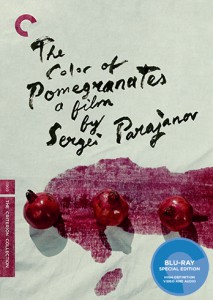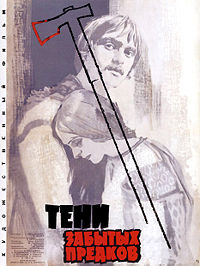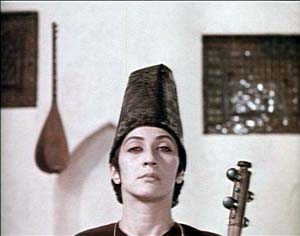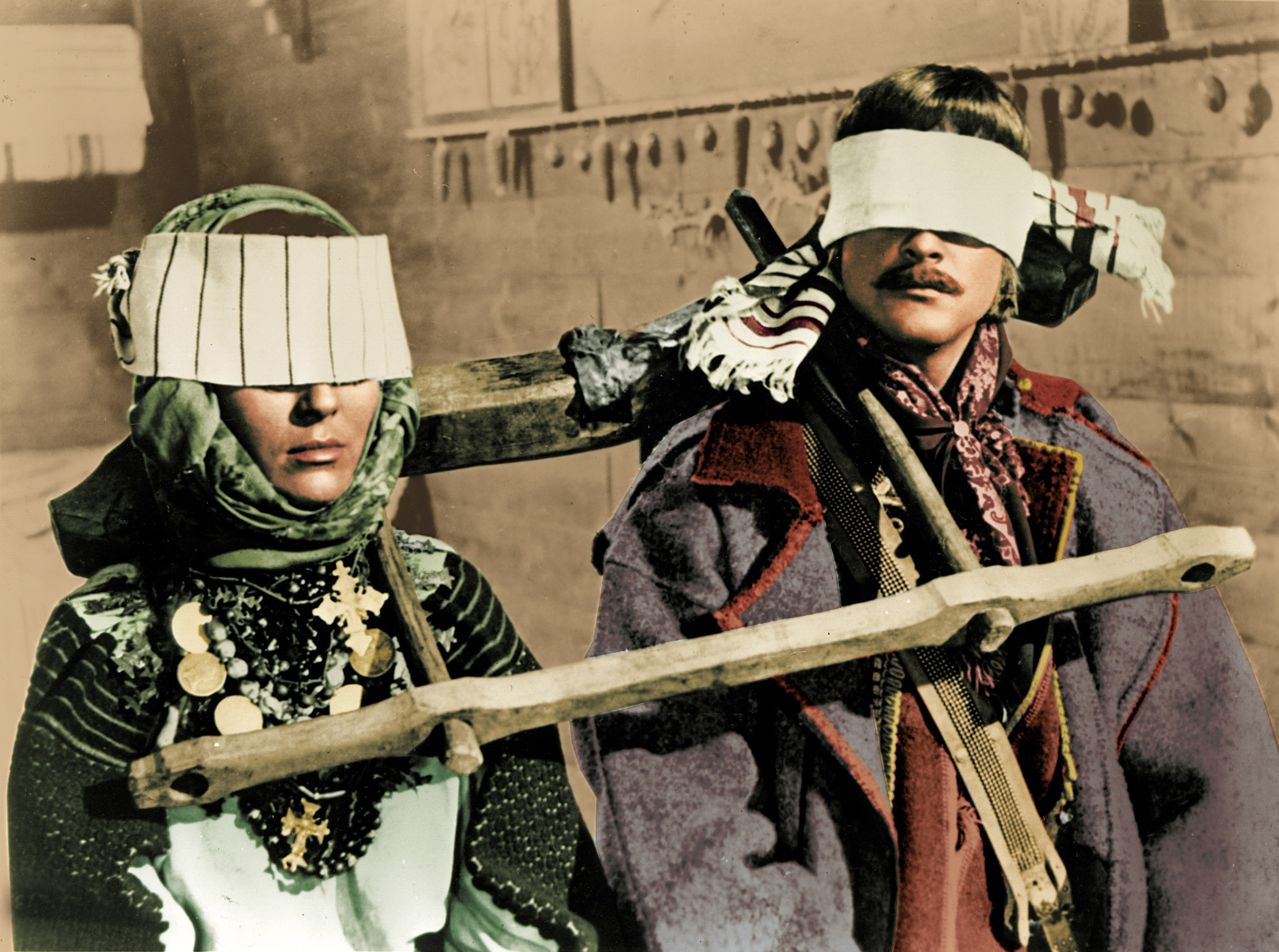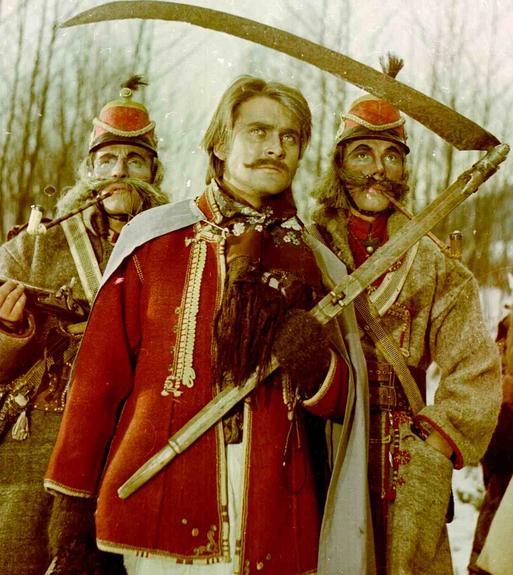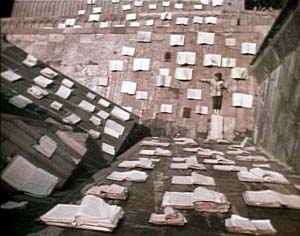The following was published in the Chicago Reader on March 25, 1988. Criterion’s edition of The Color of Pomegranates (see below) has prompted this reposting, even though a good many of the details, including the title, are now out of date. On a more timely note, check out the beautiful new restoration of Paradjanov’s long-unseen and very beautiful Kiev Frescoes, — J.R.
THE FILMS OF SERGEI PARADJANOV
by Jonathan Rosenbaum
There are few people of genius in the cinema; look at Bresson, Mizoguchi, Dovzhenko, Paradjanov, Bunuel: not one of them could be confused with anyone else. An artist of that calibre follows one straight line, albeit at great cost; not without weakness or even, indeed, occasionally being farfetched; but always in the name of the one idea, the one conception. –- Andrei Tarkovsky, Sculpting in Time
After 15 years of enforced inactivity, the greatest living Soviet filmmaker is finally back at work again, but it’s astonishing how little we still know about him––about his art, his life, or even his name. You won’t find him in Ephraim Katz’s Film Encyclopedia or in the indexes of books by Pauline Kael, Stanley Kauffman, or John Simon (among others), and as far as I know, no one anywhere has ever written a book or monograph about him.
Roughly the first half of his oeuvre, made between 1958 and 1962, has never been exported. And part of the problem with his three staggering features since then––Shadows of Our Forgotten Ancestors, The Color of Pomegranates, and The Legend of Suram Fortress––is that they’ve reached us at the rate of one per decade, with such long stretches between them that each has effectively had to be considered in isolation from the others, without the benefit of mutual illumination.
Fortunately, Facets has fixed all that, and for the next week, all three of Sergei Paradjanov’s visionary masterpieces will be screened there nightly, in two separate auditoriums. While it won’t be possible to see all three in a single session, as I did recently––a singular if exhausting experience lasting a little over four hours––one can still see them, ideally in order, over two or three evenings, and to do so is to experience a certain revelation and clarification. The greatest art always creates its own context (”We impoverish ourselves by thinking only in film categories,” Paradjanov has said), and part of what has made his work seem more difficult, esoteric, and rarefied than it actually is has been the necessity of encountering it piecemeal. (Try to imagine what our perception of van Gogh might be like if we saw only one of his paintings once every ten years.)
For much too long, we’ve known Paradjanov mainly as a martyr of Soviet repression rather than as a working artist. Born to poor Armenian parents in Tbilisi, Georgia, in 1924 under the name Sarkis Paradjanian, he pursued dance, sculpture, and (in particular) vocal music before he attended film school in Moscow in 1946, where he studied with three filmmakers who are listed in Katz’s Encyclopedia: Sergei Eisenstein, Igor Savchenko, and Mikhail Romm.
Moving to Kiev in the early 50s, where he worked at the Dovzhenko Studios, Paradjanov made all his early films in Ukrainian, including Shadows of Our Forgotten Ancestors (1964)––the film that both created his international reputation and started his difficulties with Soviet authorities. Although the mystical pantheism and lyrical exuberance of Dovzhenko are often suggested in this tale of a rural woodsman in the Carpathians––there is even one ecstatic Dovzhenko-like shot with sunflowers to acknowledge the source––Paradjanov’s vision here is already uniquely his own. A mixture of paganism, ritual, poetry, and dance underlies that vision, and as Paradjanov pointed out, “We intentionally gave ourselves over to the material, its rhythm and style, so that literature, history, ethnography, and philosophy would fuse into a single cinematic image, a single act.”
When Paradjanov refused to dub Shadows into Russian, he was charged with Ukrainian nationalism––an ironic accusation considering his Armenian and Georgian roots; his candid opposition to studio bureaucracy and his expressions of solidarity with imprisoned Ukrainian intellectuals probably didn’t help, either. In any case, he wasn’t allowed to travel with his film to any of the numerous foreign film festivals that showed it, although it reportedly received 16 separate prizes.
Finally returning to Tbilisi after 19 years in Kiev, Paradjanov found all his subsequent film projects blocked until The Color of Pomegranates––his film about the celebrated 18th-century Armenian poet, musician, troubadour, folk philosopher, and archbishop Sayat Nova––came together in 1968. Shot in Yerevan, Armenia, the film benefited from a lot of local help from museums and the Armenian church, and though it was warmly received in Yerevan when it premiered there, it was termed “hermetic and obscure” in Moscow. When Paradjanov refused to re-edit it, it was shelved for two years, then given a limited run, but only after director Sergei Yutkevich recut it, eliminating about 20 minutes and adding explanatory intertitles. (This version, alas, is the only one visible in the U.S.––although Paradjanov’s cut is reportedly in distribution in England––and because it was exported surreptitiously, only poor, duped 16-millimeter prints have been available.)
Meanwhile, Paradjanov had moved back to Kiev and had several more film projects rejected. (Apparently the one that came closest to getting made was an adaptation of Hans Christian Andersen fairy tales for Soviet TV, scripted by the father of Russian Formalism, Viktor Shklovsky.) Then in December 1973, he was arrested on multiple charges, including homosexuality, homosexual coercion, anti-Soviet activities, illegal dealings in foreign currency and art objects, spreading venereal disease, selling pornography, and “incitement to suicide.” (Reportedly, the suicide of a young male friend in Paradjanov’s circle who had contracted a venereal disease accounted for more than half of these charges.) Accounts of the trial’s outcome vary considerably: According to Sight and Sound, Paradjanov’s outspoken self-defense, which included an admission that he was bisexual, led to his sentence of six years’ hard labor in a Ukrainian prison camp for homosexuality (”a criminal offense in the Soviet Union”), while all the other charges were dropped. According to Film Comment, homosexuality “in itself doesn’t constitute a criminal offense according to Soviet law,” and traffic in art objects was the only charge retained. According to Cinema-TV Digest, the three-day trial concentrated on the charges of homosexuality and pornography, and he was sentenced to eight years. (As indicated above, it’s remarkable how little we still know about this subject 14 years later––one indication of why much of the information here remains tentative.)
After an international protest, Paradjanov was released in 1978 and allowed to return to Tbilisi, but was still kept under police surveillance and forbidden to work. Apparently he was kept alive during this period by the efforts of friends and family, although some accounts also report that he was reduced to begging in the street. He was rearrested in 1982 on charges of attempting to bribe an official, then acquitted, and was finally able to make The Legend of Suram Fortress, with Georgian actor Dodo Abashidze as codirector, in 1984. Since then, he has made at least one additional short (in 1985), has shot a feature in a Turkish castle based on a Lermontov fairy tale, and is preparing to adapt the medieval epic The Lay of Igor’s Campaign for the Ukrainians. Last month he traveled to the Rotterdam film festival––where I was fortunate enough to see him, as well as his recent short (Arabesques Around a Pirosmani Theme). Thanks to glasnost, it appears that he’s finally coming into his own.
There’s certainly reason to feel anger about what Paradjanov has been through, but it probably would be myopic to assume that, apart from his imprisonment, he would have had an easier time of it elsewhere. (Significantly, in Rotterdam he was critical of Tarkovsky’s 1983 defection from the Soviet Union, arguing that both of Tarkovsky’s last films could have been made there.) Consider the late careers of certain equally intransigent gifted filmmakers elsewhere––Carl Dreyer in Denmark, Jacques Tati in France, Orson Welles in the U.S.––and the record is about the same, roughly one released film per decade, with no slackening of interest or effort on their part. (Welles did somewhat better, but only when his movies were financed in Europe or by himself; the last time a Hollywood studio backed him was over 30 years ago.)
Formally innovative regional artists are a rare breed, and the cultures they come from seldom seem to know how to relate to them. William Faulkner, perhaps the supreme American example, may easily have been the most formally inventive novelist this country has ever produced, but he never has attracted even a fraction of the adulation and mythification assigned here to Hemingway and Fitzgerald. The big-city sensibilities that tend to rule cultural hierarchies are generally too tied to trends and other social currencies to cope with regional geniuses, eccentrics who reinvent their art from the ground up and live by their own timetables. So it shouldn’t be surprising that such supposedly esoteric figures, steeped in the intricate folklores of their respective cultures––Faulkner’s Mississippi, and Paradjanov’s Ukraine, Georgia, and Armenia––are often appreciated first in countries other than their own.
Despite frequent references to Eisenstein during his press conference in Rotterdam, Paradjanov came across as earthy and instinctive rather than intellectual––a short, bearded, and ebullient Armenian Mr. Natural who typically responded to each question with a manic, charismatic 45-minute performance that only had a glancing relation to the query posed. His half-hour short on the primitive painter Pirosmani, which one hopes will be exported soon, obeys almost none of the rules of etiquette that our pendantic art appreciations call for: canvases are accompanied by sound effects (neighing horses, chirping birds, tolling bells), subdivided into whimsical collage and montage effects, and restaged and/or reshuffled in surreal live-action tableaux that recall Joseph Cornell boxes. Yet the film succeeds precisely where such urban sophisticates as Godard (Passion), Resnais (Van Gogh, Guernica), Clouzot (The Picasso Mystery), Minnelli (Lust for Life), Huston (Moulin Rouge), and Gorin (Routine Pleasures) fail––in filming a painter’s work without giving us either a gliding Cook’s tour or a mincemeat dissection of it, guiding without shoving us into a position where we can simply (or complexly) look at it.
A related economy and simplicity underlies the three features showing at Facets, but significantly the means for achieving this quality shift radically from film to film. Unlike the four other filmmaking geniuses cited by Tarkovsky at the head of this article, as well as Tarkovsky himself, Paradjanov does not display a consistent style matching his persistent vision as he moves from film to film, but a new style to match the requirements of each work. Shadows of Our Forgotten Ancestors largely achieves stylistic self-definition through dazzling, lyrical, and mainly hand-held camera movements, while The Color of Pomegranates does without camera movement entirely; The Legend of Suram Fortress reintroduces camera movement, but in a completely different manner, restricted to functional pans that are neither hand-held nor rhetorical.
The cultures, myths, landscapes, and languages of the three features are also quite distinct: Ukrainian in Shadows, Armenian (with dashes of Georgian, Persian, and Azerbaijani) in Pomegranates, and Georgian in Suram Fortress. What remains common to all three is an absorption in folklore, magic, dance, and pagan ritual, a nearly continuous use of music, and an unusual relation to temporality that roots these films both in history and in the timeless present. The editing in all three Paradjanov features is often abrupt, and although there’s a world of difference between the narrative ellipses in Shadows and the jump cuts in the other two, the effect in all three is like that of a flat pebble skipping in bright leaps across the placid surface of a lake.
Paradjanov’s relation to narrative is also different in each feature. The episodic, linear plot of Shadows, moving from a doomed love story to a failed and childless marriage, assumes the shape and drift of the hero’s life. While Pomegranates is structured in relation to the life of the poet Sayat Nova, the narrative line is oblique to the point of near-invisibility. The plot of Suram Fortress shifts between several characters, includes a lengthy flashback, covers two generations, and is shaped by the legend of a fortress and its construction rather than the life of any single individual.
Paradjanov’s passionate involvement with his materials is always dialectically joined to a sense of serene detachment. In the precredits sequence of Shadows, we witness the sacrificial death of the hero’s brother Olexa in a snow-covered forest. Pushing the little boy Ivan out of the path of a falling tree, Olexa is crushed underneath it himself. At a crucial moment, Paradjanov cuts to a spectacular view of the event from the top of the falling tree as it plunges to the earth––placing us at the dynamic center of the action, but from the vantage point of impersonal nature rather than that of any human participant. Two deaths converge––a tree’s and a woodsman’s—in the same vertiginous movement, and the effect of this startling camera placement is neither to depersonalize Olexa nor to personalize the tree, but to link the two together in the same harsh destiny.
At Olexa’s funeral, the camera largely assumes Ivan’s viewpoint as it darts quickly from one musician to another and flees from a madman. Soon afterward, Ivan meets Marichka, a little girl his own age. Like Romeo and Juliet they come from feuding families; they fall in love, and go swimming together, naked, in a mountain stream. Then we see them as young adults eating berries together and discussing the possibility of their marriage. Later, Ivan has to leave her to work as a hired hand, and the camera does a 360-degree pan around them before they part in a rainy forest. Just before Ivan returns, Marichka dies while attempting to retrieve a stray lamb from a mountainside; Ivan and the villagers look for her, and her body is finally found in a stream below.
As if to convey the monotone of Ivan’s grief, the film turns from color to sepia while the villagers discuss his depressed state in elliptical snatches offscreen––a mode of narration that recalls the town’s perception of the Minafer family in Welles’s The Magnificent Ambersons. Then color reappears; Ivan meets another woman, Palagna, and before long they are married. When they prove unable to have children, Palagna seeks out a sorcerer and has an adulterous affair with him, which leads to Ivan’s death at the sorcerer’s hands. The last shot shows us eight children looking in through a window at Ivan’s funeral, each one framed by a separate pane.
In order to describe Paradjanov’s singular way of organizing this material, it would help to refer metaphorically to music, architecture, and landscape painting. Adopting music as our ruling metaphor, the narrative of Shadows develops in a manner that might be described as alternations between solos (Ivan and later Palagna), duets (Ivan and Marichka, Ivan and Palagna), and orchestral passages that describe the community’s collective activities and rituals. (The group search for Marichka resembles a plaintive dirge.) If the solos and duets are often lyrical, the orchestral passages are closer to mantras that weave magical spells, and the marriage and Christmas rituals of Ivan and Palagna are remarkable sequences that combine these modes in interwoven tapestries that simultaneously make us aware of individual melodies and collective harmonies.
To mix this metaphor in order to encompass the other two arts, Paradjanov’s employment of architecture and nature to shape and organize his visual compositions effectively turns these elements––the arrangement of a forest or an interior, the pattern of a window or a mountainside––into his musical staff, where his characters are set and grouped like clusters of notes. In fact, this use of indigenous architecture and landscape becomes even more central in his two subsequent features, where it often becomes impossible to separate his settings from his decor and his mise en scene.
The Color of Pomegranates is shot almost exclusively in frontal, hieratically posed tableaux that assume the shallow space of primitive cinema. While all these tableaux appear to have a literal or allegorical relationship to the life and work of Aruthin Sayadin, popularly known as Sayat Nova (the “King of Song”), and are arranged chronologically, the film veers closer to nonnarrative than it does to the continuity and development of a conventional biopic. Indeed, it seems curious that this film should be better known today than either Shadows or Suram Fortress, for it is a good deal more difficult and formally radical, even with the apparent simplifications brought about by Yutkevich’s re-editing.
One useful route into the film is Paradjanov’s own identification with the legendary poet. The opening quotation from Sayadin can indeed be read as the director’s disclaimer: “My water is of a very special kind, / Not everyone can drink it. / My writing is of a very special kind, / Not everyone can read it. / My foundation’s made not of sand, / But of solid granite.” It’s worth noting that, like Paradjanov, Sayadin was born in Tbilisi to very poor Armenian parents, wrote and sang in different languages, and was banned from practicing his art in Georgia near the end of his life.
In other respects, we don’t have to decode the images in any systematic way in order to experience their haunting power. The opening shots show three pomegranates oozing red juice on a white tablecloth, a bloodstained dagger, bare feet crushing grapes, a fish (which promptly becomes three fish) flopping between two pieces of driftwood, and water falling on books, before the poet as a little boy is introduced among these books. (One sequence shortly afterward shows him surrounded by a sea of open books on the roof of an ancient building, their pages riffled by the wind as he looks at pictures in one of them.)
Some critics have related the pomegranates and the dagger to the Turkish massacres of Armenians, but another clue is offered by a quatrain of Sayadin’s poetry in this section––each of the film’s ten sections is introduced by a separate quatrain in a printed title––which the images can be said to gather around:
While the child is growing,
The soul ripens, like fruit,
Through three elements:
Love of books,
Love of God,
Love of songs.
As the film and the poet’s life progress, many of the images become a good deal more complex. In one shot inside a spare white interior, a female figure dressed in red performs an elaborate pantomime with a transparent red cloth over the dummy of an outstretched body; behind her, an empty ornate picture frame suspended from the ceiling swings back and forth; behind that is a rotating statue of a cherub, and, behind that, a motionless and indistinct red painting or fabric. Yet even compositions as intricate as this one register as primitive and childlike–images that giggle with delight rather than brood or ponder, and that often provoke us to do the same.
While it isn’t entirely clear what material was eliminated by Yutkevich, apparently some of it featured female nudity––as did a Paradjanov short, The Frescoes of Kiev, which also encountered censorship. But if the nudity in Shadows is anything to go by, it is a kind of innocent and chaste nudity, closer to the imaginings of an Henri Rousseau than those of a Hieronymus Bosch. Much of this conscious naivete spills over into The Legend of Suram Fortress, although, once again, in a very different context. After films set in the 19th and 18th centuries, this one goes all the way back to the Middle Ages, and medieval art, theater, and literature form much of the basis of the style here. While the frontal shooting style of Pomegranates is partially echoed, a deeper use of space and a much more expansive use of landscape makes the visual style closer to tapestries than to icons. And continuity cutting, which is still used in certain portions of Pomegranates, is eliminated entirely here until the climactic sequence, making each shot an autonomous event.
In a recent interview, Paradjanov claimed that all the props and costumes used in Suram Fortress came from his own house, where he has stockpiled such items for years––a reflection of his low-budget method of shooting that helps explain how he can make his retellings of impersonal myths so personal. (Apparently because he is less fluent in Georgian than he is in Ukrainian, Armenian, and Russian, Paradjanov used one of his lead actors here, Dodo Abashidze, as a codirector because he could communicate better with the other Georgian actors.) One of the major characters, Osman—Agha, whose recounted life story forms a lengthy digression dropped into the middle of the plot, is a Georgian forced to renounce Christianity as a young man and become a Muslim, and in many respects the film’s plot as a whole deals with an encounter between East and West that makes the eventual construction of the fortress––finally effected by a human sacrifice— possible.
If Paradjanov’s films belong to any international film genre, this might be termed the ethnographic-ecstatic, a genre in which ritual plays an important role, magic is taken seriously, and national or regional folk myth is the major source of inspiration. Other recent films in this genre would include Tian Zhuangzhuang’s The Horse Thief from the People’s Republic of China and Souleymane Cissé’s Brightness from Mali (an extraordinary fantasy about the ancient Bambara culture due to open in the U.S. within the next few months); some of the period films of Jancso (Hungarian) and Pasolini (Italian) might be said to represent impure or partial examples.
Curiously, the cultural trappings of Paradjanov’s films may seem even more remote to us than those of The Horse Thief (Tibetan Buddhist) and Brightness (Bambara culture in the Middle Ages), because our distance from regional Soviet cultures is arguably increased rather than minimized by the presence of Christian iconography, which Paradjanov seems to use almost exclusively in a pagan context. While the exoticism of The Horse Thief and Brightness allows us to accept these worlds as parallel universes––much as we accept the fantasies of, say, Mervyn Peake or Olaf Stapledon––the apparent familiarity of the Christian icons in Paradjanov is more likely to confuse us than to anchor us. And like many of the other Soviet experimental films of the past two to three decades that are recently surfacing in the West, we can’t situate them easily within a film history that parallels or resembles our own, so we have to face them without the comfort of this reference point. But the sheer beauty of Paradjanov’s cinema provides its own reference; and with more of his features still to come, each new glimpse into his special world will clarify and complicate what we know still further.
Published on 25 Mar 1988 in Featured Texts, by jrosenbaum

